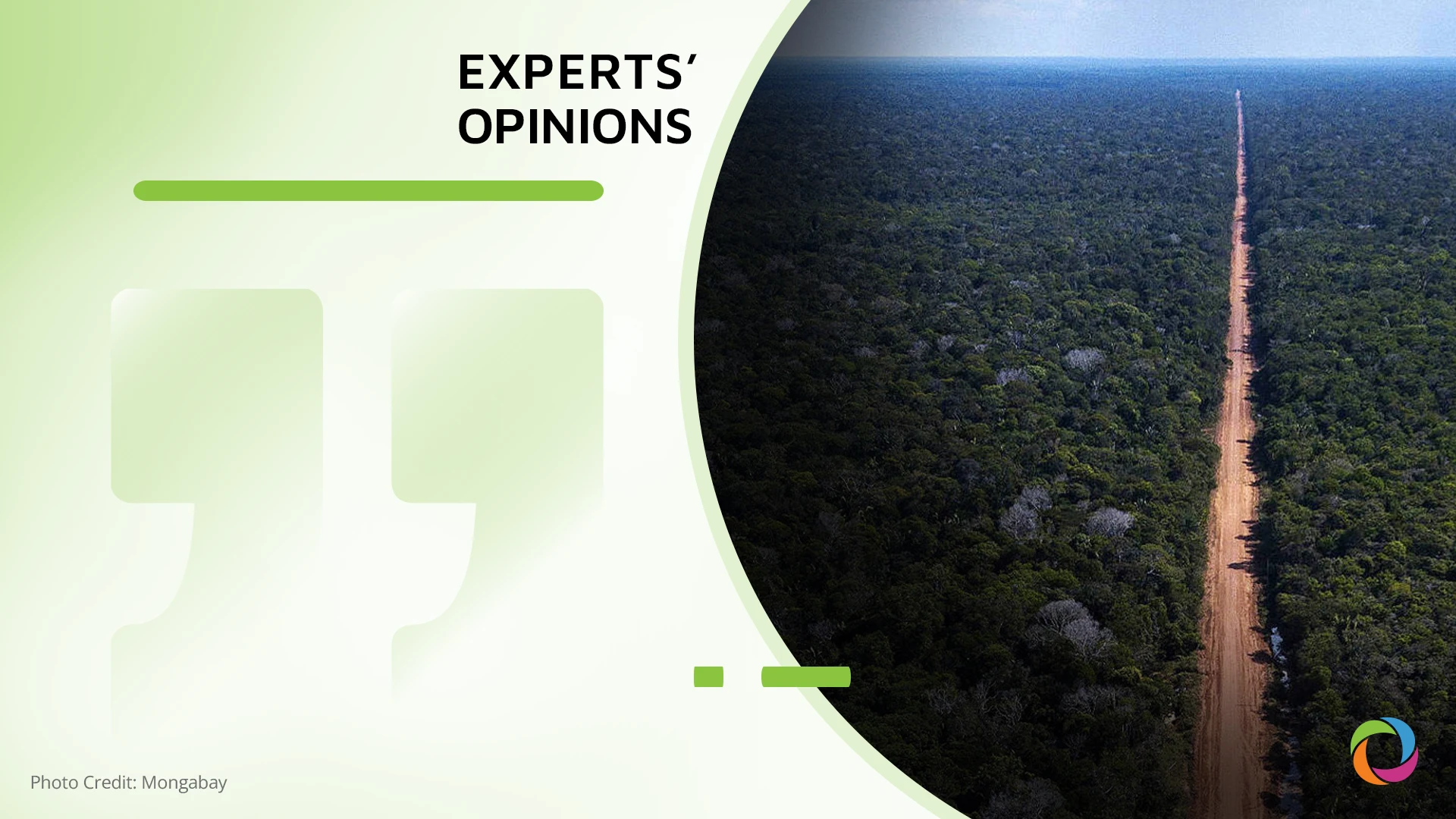The BR-319 highway is considered to be one of the most challenging drives in South America because of the crater-sized potholes and broken pavements, gravel and dirt sections that turn to mud during rainy season, no guardrails along most stretches, limited infrastructure, and very few towns, fuel stations, or bridges along the way. However, recently the highway has attracted attention for different reasons. The government’s decision to rebuild it has put the project at the center of major debates. While some experts believe the project could boost the economy in northern Brazil, others argue it will affect the environment, causing massive deforestation, biodiversity loss, and will also affect indigenous communities.
While the Government of Brazil is looking into ways to restore the environmental license to rebuild the BR-319 that was suspended by the court in July 2025, we approached several experts to ask their opinions regarding the main advantages and disadvantages of this project in terms of regional development, environmental sustainability, and social impact. Check out their insights in the article below.
Key Takeaways:
- Inaugurated in 1976, with a length of 885 km, the BR-319 highway connects the Brazilian cities of Manaus (Amazonas state) and Porto Velho (Rondônia state). The construction of the highway began in 1968 and was completed by 1973. However, in 1988, the highway became completely impassable due to constant deterioration. In 2008, repair works began, making the highway “marginally passable” through maintenance.
- Attempts to resurface BR-319 have been ongoing for almost two decades, but have been repeatedly put on hold due to environmental concerns and bureaucratic obstacles.
- According to some opinions, resurfacing the BR-319 could bring significant benefits for regional development by enhancing economic integration, expanding market access, and promoting tourism.
- Social impacts such as high costs, cultural disruption, increased crime, and unmanaged migration are among the major concerns.
- A balanced approach must weigh long-term sustainability over short-term economic gains.
DevelopmentAid: What are the main advantages and disadvantages of paving the BR-319 highway in terms of regional development, environmental sustainability, and social impact?

“From a decolonial and socioenvironmental perspective, the paving of the BR-319 represents a paradigmatic conflict between state-centric development narratives and the lived realities of Amazonian territories. While the proponents argue that the highway fosters regional integration and economic inclusion, the project reinforces extractivist logics that historically disregard the ecological and epistemic value of forest-dwelling and traditional, small-scale extractivist populations. These include Indigenous peoples such as the Tenharim, Jiahui, Apurinã, Kaxarari, Karitiana, and Uru-Eu-Wau-Wau, as well as riverine communities, rubber tappers, nut collectors’ communities, and Afro-descendant quilombolas. The risks of uncontrolled deforestation, land grabbing, and violence against these groups far outweigh the short-term benefits of logistical connectivity. Environmental impact assessments have been fragmented and politically pressured, undermining both scientific integrity and the right to free, prior, and informed consultation, as established by ILO Convention 169, to which Brazil is a signatory. Pluriverse development pathways in the Amazon must be grounded in territorial rights, ecological sustainability, and the protagonism of local knowledge systems. The BR-319, as it stands, threatens to deepen historical inequalities and ecological degradation, rather than promote a just and sustainable Amazonian future.”

“Although being highly disputable, Brazil’s decision to pave the segment of the BR-319 highway (only passable during the dry season) has some solid economic benefits such as increased activities in agriculture, cattle farming, biofuel generation, mining, and rare earths production. A direct transportation link between Manaus, Amazonas, to Porto Velho, Rondônia would permit bulk transportation in less time than riverine transport and at significantly less cost than air freight. A sustainable and responsible approach by the Brazilian government in making this vital connection of the states of Amazonas and Roraima to the rest of Brazil would serve as an economic opportunity for its local municipalities. This project has the potential to be showcased as a role model by Brazil in good governance by ensuring environmentally sustainable operations and by playing a more vital role in regulating and controlling illegal deforestation of the untouched Amazon forest. The BR-319 highway will facilitate the integration of the wild areas and their isolated indigenous population into mainstream Brazil, leading to better healthcare facilities, access to modern amenities, and a stronger voice in the Brazilian government for the indigenous people, highlighting the fact that inclusivity and not isolation is the solution in the 21st century.
But there are also some disadvantages, from the perspective of regional development, environmental sustainability, and social impact. Bad governance will aggravate the disadvantages of the BR-319 highway project. Unless regulated and controlled, the completion of the paved road (a lawless area) would open the protected indigenous territories and critical forest ecosystems in the central and northern parts of the Amazon to land grabbers, loggers, and ranchers. The paving of the highway would further expand (to the ‘Trans-Purus’ region in western Amazonas) the ‘arc of deforestation’, already irreversibly existing in the southern and eastern fringes of the Amazon forest. Thus, vast amounts of sequestrated carbon would be emitted into the Earth’s atmosphere directly or indirectly, amplifying global warming. The project faces existing challenges such as flooding in the wet season, unstable soil, high heat and humidity, and rough traffic. It would most likely lead to the construction of additional roads branching out and extending the environmental impacts far beyond the strip of the BR-319 highway. Roraima state could see an influx of migrants from the ‘arc of deforestation’ region straining the already delicate environmental balance. The project may run into funding hurdles as some international donors could disagree with the sustainable justification provided against the environmental impacts and in support of the preservation of rights of indigenous and tribal people.”

“The paving of the BR-319 represents not just a transport initiative but a significant moment for Brazil’s developmental trajectory. It presents a critical juncture that necessitates thoughtful consideration of Brazil’s climate commitments. Proceeding with this highway project without comprehensive environmental safeguards could lead to increased deforestation, potentially releasing substantial amounts of CO₂ by 2050. Such an outcome might challenge Brazil’s ability to meet its Nationally Determined Contributions under the Paris Agreement, which could impact the nation’s international standing and access to vital climate finance. Conversely, prioritizing infrastructure investments in low-carbon alternatives — such as railway corridors and improved river transport — would position Brazil favorably to leverage green bonds, climate adaptation funding, and support from initiatives like the Amazon Fund, REDD+, and the Green Climate Fund. Emphasizing these pathways ensures sustainable, long-term financing but also helps to safeguard critical forest carbon stocks globally. Additionally, the costs associated with mitigating potential damage from BR-319 — such as reforestation and enforcement initiatives — could significantly surpass the initial construction expenses. Considering the project from a climate finance perspective highlights the importance of avoiding the risk of becoming a stranded asset in a world that is increasingly oriented towards low-carbon solutions. Brazil stands at a remarkable crossroads in its efforts to capitalize on its environmental assets and foster preservation rather than depletion. By aligning decisions regarding the BR-319 with climate finance strategies, Brazil can attract international investment, protect the Amazon, and promote sustainable development for future generations.”

“Advantages: Robust road infrastructure and connectivity are foundational elements for inclusive national development. The BR-319 highway can significantly improve access to healthcare, education, and employment for remote communities, thereby reducing migration from Amazonian states to other urban centers. Climate resilience and disaster risk management are becoming a top priority for governments. From this perspective, reliable road connectivity is crucial for rapid response, offering a reliability that alternative modes of transport often cannot. Thus, a well-balanced, transparent, long-term strategy that prioritizes forest conservation complemented with eco-tourism, for example, could create a win-win scenario, ensuring environmental preservation as a critical factor to sustain local economic development. Innovative financing mechanisms, such as special tolls on certain routes, could be introduced to fund ecosystem protection initiatives in the region.
Disadvantages: However, similar infrastructure projects worldwide have often led to biodiversity loss and disruption to indigenous communities’ livelihoods. Again, from a climate resilience standpoint, maintaining roads in areas that are prone to severe natural hazards would become a continuous and costly endeavor, with minimal returns. If not managed carefully, the BR-319 could accelerate deforestation in the Amazon, pushing not just the region, but our planet itself, closer to an irreversible tipping point in the fight against climate change.”

“Paving the BR-319 could bring significant benefits for regional development by enhancing economic integration, expanding market access, and promoting tourism. It may also improve social outcomes by increasing mobility and accessibility, creating jobs, and strengthening connectivity for indigenous and riverine populations. However, without rigorous environmental safeguards, sustainable planning, and meaningful consultation with the affected communities, the project poses serious risks. These include irreversible damage to the Amazon through deforestation, loss of biodiversity, and increased carbon emissions. Social impacts such as cultural disruption, increased crime, and unmanaged migration are also major concerns. Additionally, the long-term economic burden — including high maintenance costs and the risk of underutilization — must be factored into a comprehensive cost-benefit analysis, including an evaluation of the project’s economic rate of return. Without such diligence, the project may ultimately harm the very communities it intends to support. Detailed development plans should prioritize sustainable forest management, the responsible use of forest residues (e.g., for bioenergy generation), and the provision of alternative, economically viable settlements for the affected communities. Only through balanced planning, strict environmental oversight, and meaningful indigenous participation can the BR-319 project proceed in a way that minimizes harm and maximizes shared benefits.”

“The proposed paving project of the BR-319 highway presents significant economic, environmental, and social challenges. It is imperative to identify and assess the long-term impacts, particularly those that are difficult to mitigate or are irreversible, to inform responsible decision-making. While local communities may gain economic opportunities, the project poses a serious threat to ecological stability, including vital services provided by the tropical rainforest, biodiversity, and the human populations — estimated at several million — that are reliant on these resources. Moreover, it risks causing enduring cultural, social, and economic losses, especially among the indigenous and rural communities residing in these biodiversity hotspots. Mitigating these threats requires effective access management; however, the ongoing annual deforestation rate of approximately 10,000 km² highlights that such measures are not yet assured. Implementing robust conservation strategies demands sustained effort, shifts in societal attitudes, increased awareness, and enhanced surveillance or enforcement actions to protect vital resources. The financial and human resources currently dedicated to these protective measures could instead be redirected toward sustainable resource management initiatives—initiatives that have demonstrated their effectiveness in the Brazilian context by promoting economic development while conserving environmental integrity for future generations.”

“The paving of Brazil’s BR-319 highway, linking Manaus to Porto Velho, presents both opportunities and challenges from a sustainability management perspective. On one hand, improved road infrastructure would support regional development by reducing transport costs, increasing market access, and improving connectivity for over 1 million people. This could strengthen local economies, enhance public service delivery, and reduce the economic isolation of remote communities. However, the environmental and social costs are considerable. Unregulated access to previously remote forest areas may accelerate deforestation, biodiversity loss, and greenhouse gas emissions. These environmental externalities carry significant costs not only for ecosystem health but also for national climate goals. Poor governance and limited enforcement capacity heighten these risks. From an environmental economics standpoint, the lack of valuation for ecosystem services such as carbon storage and watershed regulation undermines the long-term sustainability of the project. Similarly, in terms of social economics, the highway could disrupt Indigenous and traditional livelihoods, unless inclusive planning and compensation mechanisms are adopted. To balance development with sustainability, the project must incorporate circular economy practices, transparent monitoring, and participatory governance. Without such safeguards, short-term economic gains may come at the expense of long-term ecological and social stability.”

“The Brazilian government’s decision to pave BR-319, a highway connecting Porto Velho to Manaus, embodies a high-stakes trade-off between regional development and environmental and social preservation. On one hand, the project promises to integrate the isolated Amazonas state with national supply chains, lower logistics costs, and spur economic activity in one of Brazil’s most underdeveloped regions. For residents and local businesses, improved access could enhance healthcare, education, and market opportunities. However, the environmental costs are profound. The highway bisects vast tracts of untouched rainforest, acting as a vector for deforestation and illegal land grabbing. Studies suggest that road construction in the Amazon often triggers a “fishbone” pattern of forest clearance along its length. Paving BR-319 could fragment critical ecosystems, threaten endemic species and reduce carbon sink capacity, jeopardizing Brazil’s climate commitments. Socially, the highway endangers indigenous communities whose territories lie nearby. While proponents argue it brings development, critics highlight a lack of meaningful consultation and the risk of cultural erosion, displacement, and conflict over land rights. The BR-319 case highlights Brazil’s broader struggle: reconciling economic integration and infrastructure growth with the stewardship of the Amazon’s ecological and cultural wealth. Without robust governance and environmental safeguards, the long-term costs may far outweigh short-term gains.”

“The paving of the BR-319 highway offers both opportunities and risks. From a regional development standpoint, improved connectivity could reduce transport costs, stimulate trade, and expand access to public services in isolated areas. It has the potential to integrate northern Brazil more effectively into the national economy and support local livelihoods. However, these benefits come with significant environmental and social costs. The highway cuts through sensitive areas of the Amazon rainforest, threatening biodiversity and accelerating illegal deforestation. It also poses serious risks to indigenous and traditional communities, many of whom have not been adequately consulted. Without strong environmental safeguards and inclusive planning, the highway could exacerbate land conflicts, disrupt ecosystems, and undermine climate commitments. A balanced approach must weigh long-term sustainability over short-term economic gains.”

“While it’s true that paving the BR-319 highway offers an economic lifeline to the communities that have sprung up along its length following its initial construction by the military government, it also promises to unleash a new wave of deforestation and land-grabbing. There are already more than 6,000 km of illegal roads into the Amazon along the BR-319, which have not been closed by the government, and which have opened up the climatically vital rain forest to logging and to the creation of cattle ranches and soy farms. Brazil is obligated under ILO Convention 169 to consult with indigenous groups prior to proceeding with paving BR-319, but the vast majority of the 63 indigenous lands living within 150km of the road have been ignored. The indigenous communities in this zone can realistically expect to see major changes due to the project, but the authorities are failing to ensure they can exercise their free, prior, and informed consent over the paving of BR-319.”
See also: Amazon fires in 2024: Climate action setbacks and long-term effects | Experts’ Opinions
For experts interested in sharing their expertise in this particular area or region, DevelopmentAid offers the ability to filter their job interests by location, sector, and years of experience. More than 5,000 job openings in the international development sector are one click away, and all of them can be easily accessed and analyzed with the Individual Professional Membership. Aside from the job openings, members gain access to tenders and grants for individuals, profile exposure, contacts of organizations and funding agencies, and much more.

